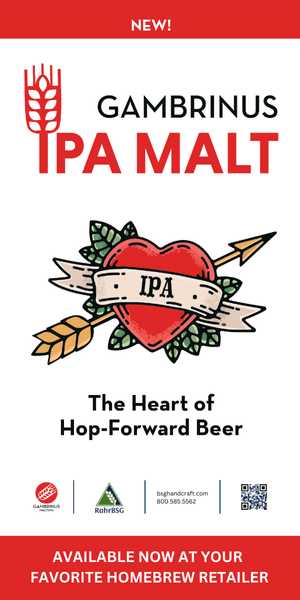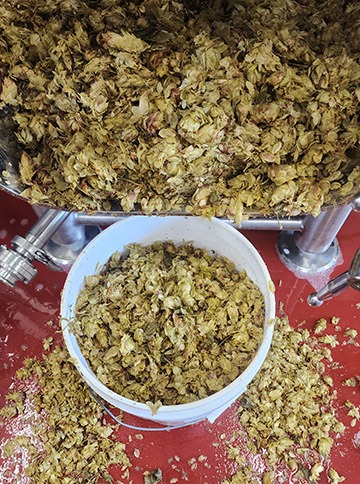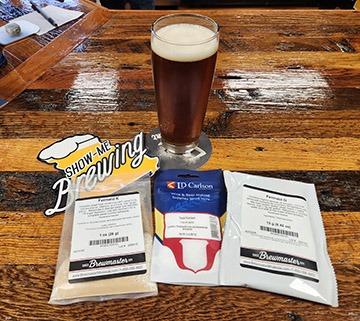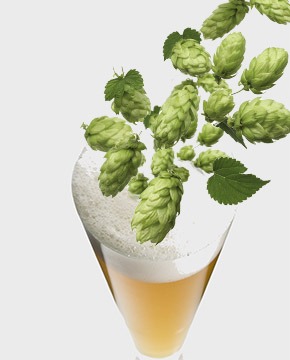
Using chili peppers in beer may not be the typical combination you think of when you’re contemplating an experimental brew. However, it’s not unusual to find many homebrewers spicing up their brew days with uncommon additives. Where would Belgian beers be without their coriander and orange peel? Where would various Christmas ales be without the holiday spices that lend them that seasonal character?
Pepper beers have long been a novelty item in the brewing world, but few commercial examples have survived for any length of time. Those that remain are something of a curiosity rather than a commercial success.
Notable examples range from the serious brewing efforts of Rogue’s Chipotle Ale, previously known as Mexicali Rogue, to the “novelty” beer aspect of Cave Creek’s Chili Beer, which has a whole serrano pepper in every bottle. Drinkability is often sacrificed in the quest for heat, lending the entire style a frivolous reputation. The base beer tends to be a light beer, one that permits the scorching heat of the pepper to dominate all other flavors. The more serious examples strive for a sense of balance in the flavors, adding the subtle burn of the pepper to punctuate crispness of the hops and offset the residual sweetness of the beer. Think hop spiciness on steroids.
Pepper Heat in Foods
If you question whether the heat of peppers belongs in beer at all, consider the flavor combinations found in dishes from around the world. Closest to home is American barbecue. Often the flavors of rich, smoked meats are complimented by a sweet-spicy sauce with a peppery finish. This heat factor varies by region, but finds its hottest incarnations in the American Southwest. South of the border, the combinations multiply, ranging from the outright heat of hot sauces to the rich and spicy mole sauce, made using chocolate.
Sweet and spicy doesn’t stop there, however, with excellent examples found wherever peppers are grown. Noteworthy examples are the potent jerk sauces from the Caribbean, the searing heat of Thai and Schezuan cuisine and the rich curries and spicy vindaloo sauces from India.
Peppers in Beer
All this talk about sweet, smoky and spicy food is all very well and good, but how does it relate to beer? The first two descriptors — sweet and smoky —suggest that there should be combinations within known beer styles that lend themselves to a flavorful pepper combination. Good examples of sweet styles would be the stronger Scotch ales, barleywines, strong Belgian ales, sweet stouts, Märzens, bocks and some wheat beers. Of course, nearly any beer can be brewed to balance to the malty side, so these are simply the more obvious choices. When it comes to smoke, there are fewer stylistic examples to work with, but the classic rauchbiers and Scotch ales with their smokier influences are a logical place to start.
On the opposite end of the scale are the “light” examples. A lighter beer permits the heat and delicate flavors of a pepper to be emphasized with few competing flavors. In this case it’s not so much about the flavor combination, it’s a case of letting the pepper’s essence shine through. Light lagers, cream ales and wheat beers are all well suited to this role.
Pepper Varieties
Beyond choosing the beer’s style, you need to decide on what pepper to use and the relative degree of heat you expect to get from it. Depending on the variety, you will also have to judge how much is necessary to achieve the desired level of pepper effect. Peppers come in a variety of shapes, colors and sizes. Red, green, yellow and orange are common colors, but the color doesn’t necessarily have any bearing on the heat of the pepper. Spiciness, or pungency, is measured in “Scoville units.” This form of measurement is named for a Parke-Davis scientist, Wilbur Scoville, who established a means to test the flavor concentration of capsaicin in various peppers. Pure capsaicin registers at a stunning sixteen million Scoville units, while the hottest pepper, the habanero (aka: Scotch bonnet) tops out at a mere 350,000 units! (For reference, the average jalapeño pepper is between 2,500 and 5,000 Scovilles.) Clearly, it will take more jalapeños than habaneros to spice up your brews. An important fact to remember is that capsaicin is not very soluble in water, but is readily soluble in alcohol, which is critical in the beer flavoring process. When choosing your peppers, be sure to look for a smooth and glossy finish, with even coloration. They should also be firm to the touch, but not hard.
Preparing peppers
Once your peppers have been washed, you’re ready to prepare them for the brewing process. It goes without saying that surface area is a factor in the uptake of the pepper flavors, but you should take care to leave pieces large enough to allow for easy racking between vessels. When preparing your peppers for use, simply cutting out the stem and removing the seeds and dicing them is usually sufficient. Be sure to retain as much of the white “ribs” as possible and as much of the stem end as you can if heat is a goal of yours. The highest concentrations of capsaicin reside in the ribs and stem areas (not the seeds, as is commonly believed). Roasting the peppers can add an extra dimension to their character, but be careful not to overdo it, unless you want a distinctly burnt character to the flavor from charred edges.
Handling raw peppers isn’t something to take lightly. They can burn your mouth, certainly, but what many brewers fail to realize is they can also burn your skin. Wear impermeable gloves when handling cut peppers and be sure to not touch your eyes or nose unless you want a painful lesson. If you forget these precautions, you can expect painful, burning and swollen hands for several hours.
Choosing your method for flavoring your beer depends on several factors. First is the size of your batch. Very few people find 5 gallons (19L) of pepper beer useful or even desirable. However, it is certainly possible to make it in large quantities, since commercial producers have been doing so for years. For large-scale production, it’s simply a matter of steeping the peppers in the beer or wort. Depending on your preference, this can be done after the boil, when the wort is still hot and can sanitize the peppers, or during secondary fermentation, when the risk of infection is lower (although not entirely absent.) The advantages to steeping in the kettle are obvious. First, you have very little risk of contamination and second, the heat tends to extract both the capsaicin and some of the pepper flavors, which add depth to the flavor profile. The chief disadvantage is the loss of aromatics during primary, resulting in a weaker pepper aroma. Adding the peppers in the secondary will allow the alcohol present to more readily bind with the capsaicin, but there’s the added risk of infection and the lack of heat to break down some of the pepper flavors. The advantage of this method is that you don’t have to use all your wort to make a pepper beer. Instead you can dose a portion of your batch and simply test the results until the desired level of heat is obtained.
A second strategy, and one that allows for more experimentation is to create a pepper tincture and then dose your beer with that solution until the appropriate level of heat and flavor is reached. Making tinctures is very straightforward. Depending on the amount of time you’re willing to spend, you can make a pepper extract within the space of a few weeks. What’s required is flavorless 80–100 proof vodka, peppers and patience. The risk of contamination is minimal and you have complete control over how potent the final product is. The basic process is very simple. Slice, dice, or puree your flavoring ingredient and place it into an airtight container. Then add sufficient vodka to cover it completely with about 3/4 inch (2 cm) extra liquid above the ingredient. (Increase the amount of “overhead” if your flavorings are dried, as they will absorb some of the vodka during the extraction process.) Let the solution stand at least one week, ensuring that the flavoring ingredients are completely submerged the entire time. Don’t hesitate to add more vodka, if necessary and you may agitate the solution to ensure thorough mixing. The longer the mixture sits, the more potent it will become. Also, using dried ingredients is supposed to increase a tincture’s pungency by a factor of ten. When you’re ready to create your pepper beer, simply strain the flavorings out of your tincture and dose the base beer with enough of the tincture to create the desired flavor profile. Be very careful when handling a hot pepper tincture; the liquid will sting badly if gets anywhere on your body.
This technique served John Jurgensen of the Bay Area Mashtronauts well, winning him a first place medal at the American Homebrewers Association’s National Homebew Competition for his Peppered Honey Wheat. “I wanted a beer with flavors that aren’t complex” he responds when asked about his choice of base beer. “I’ve tried lagers and I prefer the honey wheat.” His tincture is simple, with a single Anaheim pepper, diced and immersed in Everclear (190 Proof) for several days, which is then augmented with a single diced jalapeño and steeped a further week or more. Using Everclear produces no advantage over plain vodka, and in fact can add an alcohol flavor to your final product if used in excess. Determining how much to use in your beer is simply a matter of a scaled taste test, adding a fixed number of drops to a known volume of the beer and evaluating the effect. Once the proper flavor is achieved, he determines the full-bottle proportions then doses his honey wheat beer (after bottle conditioning) with the tincture and caps the bottles again.
A well-balanced example of a pepper beer opens new horizons for many beer drinkers while providing a diversion to the brewer who wants to stretch their creativity.
Recipes
John’s Peppered Honey Wheat
(5 gallons/19 L, all-grain)
OG = 1.055 FG = 1.014
IBU = 19 SRM = 5 ABV = 5.3%
Ingredients
6.1 lbs. (2.8 kg) German wheat malt
3.4 lbs. (1.5 kg) Belgian Pilsner malt
1.2 lbs. (0.54 kg) honey
1 Anaheim pepper
1 jalapeño pepper
4.4 AAU Tettnanger hops (55 mins) (1.1 oz./31 g of 4.0% alpha acids)
0.5 oz. (14 g) Tettnanger hops (15 mins)
1 tsp. Irish moss
2 tsp. yeast nutrient
White Labs WLP008 (East Coast Ale) yeast
0.75 cup corn sugar (for bottling)
Step by Step
Mash grains for 60 minutes at 154 °F (68 °C). Sparge for 6.5 gallons (25 L) of runoff and add honey five minutes from the end of the two-hour boil. Add Tettnanger hops at times indicated. Add Irish moss at knockout. After chilling, add yeast nutrient and pitch yeast. Ferment at 70 °F (21 °C). Make pepper tincture according to instructions in main text.
Wee Little Hottie
(5 gallons/19 L, all-grain)
OG = 1.085 FG = 1.021
IBU = 25 SRM = 29 ABV = 8.2%
Ingredients
14.5 lbs. (6.6 kg) Maris Otter pale malt
1.75 lbs. (0.79 kg) British dark crystal malt
0.5 lbs. (0.23 kg) Belgian Carapils
0.38 lbs. (0.2 kg) peat smoked malt
0.25 lb. (0.11 kg) biscuit malt
0.125 lbs. (56 g) chocolate malt
7.5 AAU UK First Gold hops (FWH) (1.5 oz./43 g of 5.0% alpha acids)
1.0 oz. (28 g) UK Fuggles (10 mins)
1.0 lb. (0.45 kg) jalapeño peppers
White Labs WLP007 (Dry English Ale) or White Labs WLP028 (Edinburgh Ale) yeast
0.75 cup corn sugar (for bottling)
Step by Step
Mash in for 90 minutes at 158 °F (70 °C). Sparge and runoff around 7–7.5 gallons (26–28 L) of wort. Boil for 90 minutes, with UK First Gold hops as first-wort hops and UK Fuggles added with 10 minutes remaining. Cut jalapeños in half, remove seeds and roast for about 20 minutes in a 250 °F (121 °C) oven. Steep peppers at the end of the boil for at least 30 minutes. Aerate and pitch yeast. Ferment at the lower end of your yeast’s temperature range.
The Mole (Chipotle Porter)
(5 gallons/19 L, extract with grains)
OG = 1.053 FG = 1.013
IBU = 25 SRM = 49 ABV = 5.1%
Ingredients
2.5 lbs. (1.1 kg) Briess light dried malt extract
3.3 lbs. (1.5 kg) Muntons Light liquid malt extract
0.75 lbs. (0.34 kg) crystal malt
1.0 lb. (0.45 kg) chocolate malt
5.0 oz. (142 g) black patent malt
6.6 AAU Willamette hops (60 mins) (1.33 oz./38 g of 5% alpha acids)
Wyeast 1968 (London ESB) or White Labs WLP002 (English Ale) yeast
8 chipotle (dried, smoked jalapeño) peppers
0.75 cup corn sugar (for bottling)
Step by Step
Steep grains in 2/3 gallon (2.5 L) of water at 150 °F (66 °C) for 45 minutes. Add “grain tea” and dried malt extract to brewpot to make 3 gallons (11 L) and bring to a boil. Boil hops for 60 minutes. Add liquid malt extract for final 15 minutes of the boil. (Stir well to prevent scorching.) Cool wort, aerate and pitch yeast. Ferment at 70 °F (21 °C). Make pepper tincture by soaking dried peppers in vodka.
 Using chili peppers in beer may not be the typical combination you think of when you’re contemplating an experimental brew. However, it’s not unusual to find many homebrewers spicing up their brew days with uncommon additives. Where would Belgian beers be without their coriander and orange peel? Where would various Christmas ales be without the holiday spices that lend them that seasonal character?
Pepper beers have long been a novelty item in the brewing world, but few commercial examples have survived for any length of time. Those that remain are something of a curiosity rather than a commercial success.
Notable examples range from the serious brewing efforts of Rogue’s Chipotle Ale, previously known as Mexicali Rogue, to the “novelty” beer aspect of Cave Creek’s Chili Beer, which has a whole serrano pepper in every bottle. Drinkability is often sacrificed in the quest for heat, lending the entire style a frivolous reputation. The base beer tends to be a light beer, one that permits the scorching heat of the pepper to dominate all other flavors. The more serious examples strive for a sense of balance in the flavors, adding the subtle burn of the pepper to punctuate crispness of the hops and offset the residual sweetness of the beer. Think hop spiciness on steroids.
Using chili peppers in beer may not be the typical combination you think of when you’re contemplating an experimental brew. However, it’s not unusual to find many homebrewers spicing up their brew days with uncommon additives. Where would Belgian beers be without their coriander and orange peel? Where would various Christmas ales be without the holiday spices that lend them that seasonal character?
Pepper beers have long been a novelty item in the brewing world, but few commercial examples have survived for any length of time. Those that remain are something of a curiosity rather than a commercial success.
Notable examples range from the serious brewing efforts of Rogue’s Chipotle Ale, previously known as Mexicali Rogue, to the “novelty” beer aspect of Cave Creek’s Chili Beer, which has a whole serrano pepper in every bottle. Drinkability is often sacrificed in the quest for heat, lending the entire style a frivolous reputation. The base beer tends to be a light beer, one that permits the scorching heat of the pepper to dominate all other flavors. The more serious examples strive for a sense of balance in the flavors, adding the subtle burn of the pepper to punctuate crispness of the hops and offset the residual sweetness of the beer. Think hop spiciness on steroids.





